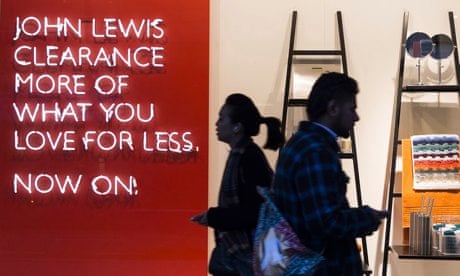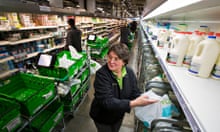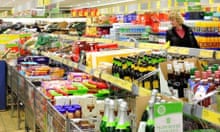1 WE ARE ALL BUYING ONLINE
Shoppers just can't get enough of the internet. We've been buying online for years, but the pace of change took even experienced retailers by surprise. Online sales of non-food items rose by nearly a fifth in December, according to the British Retail Consortium and accountant KPMG – the fastest rate since March 2010. In the grocery market as much as 15% of UK sales, worth £900m, is thought to have been booked online between 20 and 23 December, compared with an average of 5.5% throughout 2013.
Stores which excel online, including John Lewis, House of Fraser and Next, enjoyed a bumper Christmas; those struggling to keep up, such as Marks & Spencer and Morrisons, suffered.
As shoppers' confidence in delivery systems grows, they leave online orders later and later. This probably means an end to Cyber Monday – the first working day in December, when millions of orders placed on work computers made it the busiest online shopping day of the year. This year, the Sunday and Monday of the following week were just as busy.
2 CRAZY FOR CLICK AND COLLECT
Buying online may be popular but waiting in for deliveries is not. No surprise, then, that "click and collect" – a service devised by Argos, where shoppers buy or reserve items online then pick them up in a shop or other convenient location – is booming.
According to research for mobile operator O2 by Conlumino, more than a third of shoppers use click and collect services, and use is expected to rise by 12% this year. John Lewis saw click and collect sales rise 60%, while Tesco said 70% of its online orders for fashion and homewares were collected in stores.
Retailers are driving the trend with a range of new ideas – from Asda's pick-up points in tube station carparks, to Amazon lockers inside Co-op stores and the rise of Collect Plus, which lets shoppers pick up items from thousands of local convenience stores.
3 IT'S A MOBILE WORLD
Who wants to shop at work with their boss looking over their shoulder? Online sales are being driven by smartphones and tablet computers, which shoppers use to browse and buy on the bus or from their sofa.
Tesco said more than a third of its online grocery orders were placed on a mobile device in the runup to Christmas. John Lewis said three quarters of its web traffic on Christmas Day came from such gadgets. Marks & Spencer said orders from tablet computers had more than doubled, while sales via phones were up 80%. Retailers are also seeing spikes in business at new times of the day – early morning, when people purchase from bed, and around 8pm, when shoppers are also watching TV.
4 WE ARE BUYING LESS FOOD
With food-price inflation running at about 2.5%, shoppers are not only saving money by shopping around for a bargain, we are simply buying less food. Sainsbury's, Tesco and Morrisons all admitted that the volume of food sold had fallen. Of course, the middle market stores have lost some food sales to discounters such as Aldi, but the signs are that consumers are also buying more carefully and throwing less away in a bid to save money and protect the environment. Figures from Wrap, the government-backed recycling and waste body, shows that since 2007 households have cut avoidable food waste by 21%. It says every household still throws away the equivalent of six meals a week, costing an average £60 a month, so with finances under pressure the trend to cut waste is likely to continue.

5 GOODBYE OUT-OF-TOWN SUPERSTORES
All the big supermarket chains admit that sales in their once all-conquering hypermarkets were down this Christmas as shoppers switched to buying little and often or ordering online. With petrol prices high, driving miles to save a few pounds in a big store – where you might also make impulse purchases – is far less popular.
Sales at Morrisons, which has just 85 small local shops, dived 5.6%, while convenience store chains including the Co-op and Nisa saw strong growth. Sainsbury's and Marks & Spencer were also helped by their large portfolio of smaller shops. Overall sales at Tesco, which has the most convenience stores, slid 2.4%, but it would have been worse without the 1.3% rise in underlying sales at its smaller shops. Chief executive Philip Clarke said Aldi and Lidl's strategy to "get among the chimney pots" in residential areas, was part of the reason for their success.
6 SHOPPERS LIKE DISCOUNT BUYS – AND PREMIUM RANGES
Aldi and Lidl have been causing big problems for the big grocers all year, but in previous Christmases shoppers have returned to mainstream favourites for better-quality festive food. Morrisons chief executive Dalton Philips laid it out most clearly, admitting that his chain's sales had taken a battering as shoppers stayed with the discounters. The discount shops have raised their quality and are winning fans by flagging up luxury foods, from champagne to lobster, at Christmas. The non-food discounters, from Poundland to B&M Bargains, are also thought to have had a good 2013, setting themselves up to for a jump onto the stock market this year.
But it's not all about bargains. Major grocers, and mainstream clothing stores such as M&S and Debenhams, appear to be suffering in the "squeezed middle". Shoppers with spare cash are opting for premium labels. In food, Waitrose and M&S did well, as did upmarket fashion stores such as Ted Baker, House of Fraser and Jigsaw.
7 WE CAN'T RESIST A GADGET
The major electronics retailers have yet to reveal their hand on Christmas trading, with Dixons and Home Retail Group, owner of Argos, both due to report on Thursday, but it seems clear that 2013 was the year of the gadget. Sales of clothing and old-fashioned toys took a battering as families snapped up iPads and new cheaper tablets such as Tesco's Hudl – the grocer sold 400,000 of the £119 devices – as well as games consoles Playstation 4 and Xbox One. John Lewis said it sold one iPad every 10 seconds in the runup to Christmas.

8 SHOPPERS ARE SAVVIER
The traditional game of high street chicken is becoming suicidal for retailers as shoppers wait later and later to buy gifts in the hope of a bargain. Major retailers all talked of booming December sales and a lacklustre October and November, which spooked many into an early round of discounting. Mobile and online tools help shoppers compare prices and grab bargains more effectively than ever.
Shoppers once loyal to a certain grocer have become promiscuous as they search for value and respond to a blizzard of discount vouchers. Tesco and Sainsbury's use their loyalty card schemes to target offers of big savings – such as £6 off a £40 shopping basket. Morrisons' old-fashioned spend and save plan just couldn't compete.
Marks & Spencer followed other retailers with an almost unprecedented 30% reduction on knitwear, and then all clothing, just before Christmas. It says this helped it maintain market share, but angry shoppers who splashed out early will be encouraged to buy later next year. They may also have returned items, then bought them again at the lower price. M&S's profits are likely to show the cost of that move.
9 BLACK FRIDAY HAS LANDED
The US discount day Black Friday burst onto British high streets this year. This has long been a tradition over the Atlantic, with retailers offering deals to coincide with the national holiday after Thanksgiving. Black Friday is so named because it is traditionally the day retailers begin to make a profit or move "into the black". US-owned retailers such as Asda and Amazon have used it for a while, but this year it was taken up by UK stores including John Lewis and Dixons, both of which intend to stick with the idea next year.
10 CHRISTMAS HAS GONE ALL SOCIAL
The days of the cheesy celebrity-laden Crimbo ad campaign may be numbered. Yes, Heston Blumenthal was flashing his pans for Waitrose, and Rosie Huntington-Whiteley's clothes were falling off for Marks & Spencer, but this year it was all about generating interest on the internet.
John Lewis set the pace with its Disney-style bear and hare ad, which was launched with unbranded teaser ads on ITV aimed at generating chat on Twitter under the hashtag #sleepingbear. The ad went on to get more than 11m views on YouTube, while Sainsbury's clocked up more than 1m views for its Christmas in a Day mash-up of family videos.
It's cheaper, apparently keeps shoppers more loyal and is an increasingly important part of the way retailers communicate with shoppers.






Comments (…)
Sign in or create your Guardian account to join the discussion